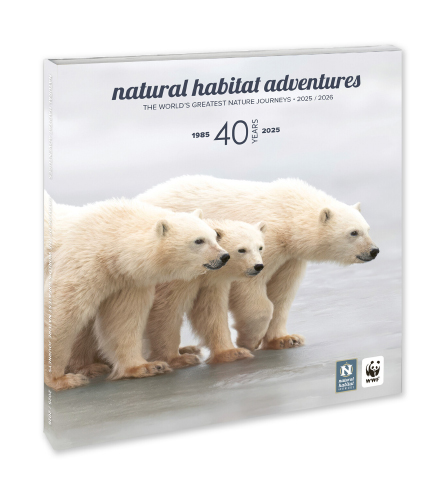Itinerary
Lindblad Expeditions’ 10-day Galapagos adventure aboard the National Geographic Delfina offers a personalized context for exploring this natural wonderland aboard a 16-passenger luxury motorsailing catamaran. While exact itineraries vary and are guided by Galapagos National Park Service rules, each voyage offers a range of exploration options and daily excursions to bring you close to a host of wildlife.
Guests may choose to arrive in either Quito, Ecuador’s capital city, or coastal Guayaquil, a vibrant tropical metropolis with a waterfront promenade along the Rio Guayas. Guests in Quito will have the choice of several hotels, while those who arrive in Guayaquil will spend the night at the Hotel Oro Verde, a recently renovated luxury hotel with a full-service spa.
Day 2: Quito or Guayaquil / Baltra, Galapagos / Embark Ship
Fly this morning to the Galapagos, landing on the island of Baltra, and transfer to the pier where the National Geographic Delfina awaits. The newest and most intimate addition to Lindblad Expeditions' Galapagos fleet, this 16-passenger luxury motorsailing catamaran is your home base for an extraordinary week of exploration. As you settle in on board, the Delfina sets off, its sleek design and stable features ensuring smooth transit between islands.
Days 3–8: Cruising the Galapagos Islands

Each day unveils a new island to explore, and Lindblad’s flexible expedition style offers diverse opportunities for discovery. Below is a selection of islands we may visit. In each location, you’ll have close encounters with the unique wildlife of the Galapagos, known for its comfort around humans. Daily activities cater to various interests and energy levels. Join expert naturalists on guided hikes, snorkel with tropical fish and sea turtles, kayak along scenic coastlines, or try stand-up paddleboarding in tranquil bays. For a different perspective, hop aboard a Zodiac to cruise rocky shores where you’ll likely find blue-footed boobies, marine iguanas and Sally lightfoot crabs. Myriad daily options allow you to tailor the experience to your preferences.
Your itinerary will include a selection of these islands:
North Seymour
Encounter abundant sea lions, nesting frigatebirds, plus land and marine iguanas, and enjoy striking views on a coastal walk.
Bartolome
Ascend to the summit of this 300-foot-high volcanic summit, then look for marine life as we swim and snorkel from the beach, keeping an eye out for rare and endangered Galapagos penguins.
Santiago
Once a source of fresh water, wood and tortoises for buccaneers and whalers, Santiago was also previously home to a thriving salt mine, active in the 1920s and 1960s. Today, the island is home only to wildlife—particularly the Galapagos fur seal—and stands as a showcase to successful conservation efforts that have recovered much of Santiago’s vegetation and native species. Explore tide pools; swim, snorkel, kayak and paddleboard along the coast; or stroll through a revitalized coastal forest.
Isabela
Isabela, largest of the Galapagos islands, was created when six volcanoes flowed together (five of which are still active). Today, its shape resembles a seahorse. In addition to kayaking and deep-water snorkeling, there's excellent swimming from a small black sand beach. Varied choices for walks and hikes ashore reveal Isabela's intriguing features, including an iguana colony and a chance to cross the equator at Ecuador Volcano, the northernmost of Isabela’s six great shield volcanoes. Keep an eye out for whales and dolphins as we ply waters rich in marine life, which were once the haunt of whalers and pirates.
Fernandina
The youngest and most active volcano in the Galapagos, Fernandina is one of the most pristine tropical islands on Earth. Hike over relatively recent lava flows among placid marine iguanas (the largest population in the Galapagos), flightless cormorants, and bright orange Sally Lightfoot crabs that speckle the black lava rocks. Galapagos hawks soar overhead while sea lions loll on the sunbaked lava.
Española
Española is one of the most prolific wildlife sites in the Galapagos. Hike to Punta Suarez, the seasonal home of the world's only population of waved albatross. The island's endemic red-and-green marine iguanas are also found only here. Española is also home to Darwin’s finches, Galapagos mockingbirds, Galapagos hawks, Galapagos doves, Nazca boobies, and the famous blue-footed boobies. A huge colony of sea lions lazes on the beach at Gardner Bay, covering the long stretch of fine, powdery white sand. Snorkeling in the bay is generally excellent, too.
Floreana
One of the few Galapagos islands inhabited by humans, Floreana has a rich cultural history filled with intrigue, including tales of pirates who once hid out here. A post office established by British whalers in 1793 is still used by travelers today to leave mail for personal delivery by passing visitors. Snorkel among sea lions and schools of tropical fish in the clear waters off Champion Islet, where flamingos, pintail ducks and various shorebirds can also be found. Hike to a pristine white sand beach, a favorite nesting site for sea turtles.
Santa Cruz
Call at Puerto Ayora, the largest town and headquarters of both Galapagos National Park and Charles Darwin Research Station, which operate in partnership. At Darwin Station, learn about collaborative efforts between scientists, guides, rangers and park managers to preserve the unique features of the UNESCO World Heritage Site that is the Galapagos Islands. Visit the tortoise-rearing facility to see tiny babies bred to help increase the depleted tortoise population, a central part of the station's conservation mission. To date, more than 5,000 tortoises have been returned to the wild in the Galapagos through the program. Santa Cruz is also home to wild Galapagos tortoises, the islands' namesake, which dwell in the misty Scalesia forests of the highlands.
Genovesa
Sail across the Equator to the remote northern realm of the Galapagos into this flooded caldera, the remnants of an ancient volcano that collapsed into the sea. Horseshoe-shaped Genovesa is renowned for its abundant birdlife, hosting more than one million seabirds. A climb up Prince Philip’s Steps, a steep stairway carved into the rock face, leads to the island’s summit. Native wildlife abounds, from Nazca, red- and blue-footed boobies and frigates to gulls and owls. The island’s cliffs and waters are also home to an array of marine life, including fur seals, hammerhead sharks, turtles and manta rays.
San Cristobal
Search for red-footed boobies and the endemic mockingbird and lava lizard—found only on this easternmost island. Explore Baquerizo Moreno, where sea lions thrive in the middle of town.
Day 9: Galapagos Islands—Disembark / Guayaquil or Quito
Our ship has returned to our disembarkation port overnight, and we depart after breakfast this morning, heading to the airport for our flight back to the mainland. You may choose to overnight in Guayaquil, where a transfer is included to the Hotel Oro Verde, or in Quito, where a choice of hotels is available. The afternoon and evening are at your leisure. Depending on flight schedules, you may be able to take advantage of an overnight flight home.
Day 10: Guayaquil or Quito / Depart
You are free to depart at any time today. A transfer to the airport is included. Fly homeward or stay on for an optional extension to Machu Picchu in Peru.
Learn more about the seasonal variations of Galapagos weather and wildlife viewing .

























